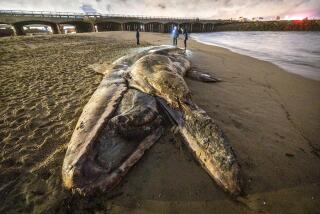Whooping Cranes Tarry at Brink of Extinction : Breeding programs have succeeded only partially. The rare birds have their own ideas about mating and nesting.
- Share via
BOSQUE DEL APACHE, N.M. — Snow-white and ungainly on spindly legs, whooping cranes stride through the cornfield stubble, conspicuous amid hundreds of gray sandhill cranes with whom they share this wildlife refuge.
In flight, these wading birds assume a powerful grace. At this time of year they are joining their smaller sandhill cousins on the 800-mile migration to their summer nesting areas in southeastern Idaho and northwestern Wyoming.
This may be the last year the 12 rare whooping cranes here make the trip. Wildlife biologists say that, while more than 200 whoopers exist, these dozen birds represent the failure of a 17-year effort to reintroduce in the wild a migratory flock of this endangered species.
“We were testing a lot of different things and we got a lot of answers,” said James Lewis, whooping crane coordinator for the U.S. Fish and Wildlife Service. “We were disappointed we didn’t develop a self-sustaining population.”
The problem, Lewis said, is that the big birds lack libido. “They have not done anything, basically,” he said. “They have not reproduced.”
This failure is the latest chapter in a 50-year effort to bring Grus americana back from the brink of extinction.
Whooping cranes, which stand five feet tall with black-tipped wings spanning seven feet, once ranged over North America. By 1941, hunting, habitat destruction and a low reproductive rate had so depleted their numbers that only 16 migratory whooping cranes survived--in a group that traveled between northwestern Canada and the Aransas National Wildlife Refuge in Texas. Six other birds in a non-migratory Louisiana flock died or were captured by 1950.
When conservation efforts increased the size of the Aransas flock, biologists in the mid-1960s started a captive flock at Maryland’s Patuxent Wildlife Research Center, using eggs taken from summer nests in northern Canada. Another captive flock has since been established in Wisconsin.
In 1975, at the suggestion of biologist Rod Drewien, the Fish and Wildlife Service decided to establish a flock of migratory whoopers at Grays Lake National Wildlife Refuge in Idaho, using sandhill cranes as foster parents.
When eggs from Canada and from the captive flock were placed in sandhill nests, the foster parents readily hatched and adopted the young whoopers and taught them the migratory route to this wildlife refuge in central New Mexico.
“The basic biology of the two species, when it comes to breeding, is very, very similar,” Drewien said. “It’s this trip south that imprints in the brain of the crane where the wintering ground is.”
This Rocky Mountain flock peaked at 37 in 1985, but the whoopers, which mate for life, were not pairing. The males, some of which staked out territory at Grays Lake and built nests, were not the problem, Drewien said. The females, it seemed, had little interest in the males.
One theory is that female whoopers were imprinted on male sandhill cranes by their foster upbringing, said Drewien’s colleague, Wendy Brown. Although this has occurred in other bird species, there is no evidence of it in whooping cranes, she said.
Another explanation is that there are too few birds in the flock to form sub-adult groups, in which the birds typically meet and choose mates.
“The problem is, you have a very, very small population of birds, and you’re trying to get them together,” Brown said. “What they’re doing is probably very normal behavior, but it’s made it very difficult for this project.”
The birds’ numbers were reduced by a long, habitat-withering Idaho drought at Grays Lake, by avian diseases and by collisions with power lines during migratory stopovers in the San Luis Valley of southern Colorado, Brown said.
Whatever the reasons for the experiment’s failure, the whooper recovery program is at a crossroads.
Some scientists have suggested moving the birds to start a captive flock in Canada, or a wild but non-migratory flock in Florida.
Another plan would pair wild males and females in a large enclosure, then release them. Finally, the flock could be left alone to see whether adults would act as foster parents to young whoopers hatched in captivity.
Drewien said the United States and Canada should agree on a course of action this summer. He would like to see a third captive flock and several other wild populations.
“If that could be accomplished,” he said. “I think most people would feel secure with the long-term status of the whooping crane.”
More to Read
Sign up for Essential California
The most important California stories and recommendations in your inbox every morning.
You may occasionally receive promotional content from the Los Angeles Times.













